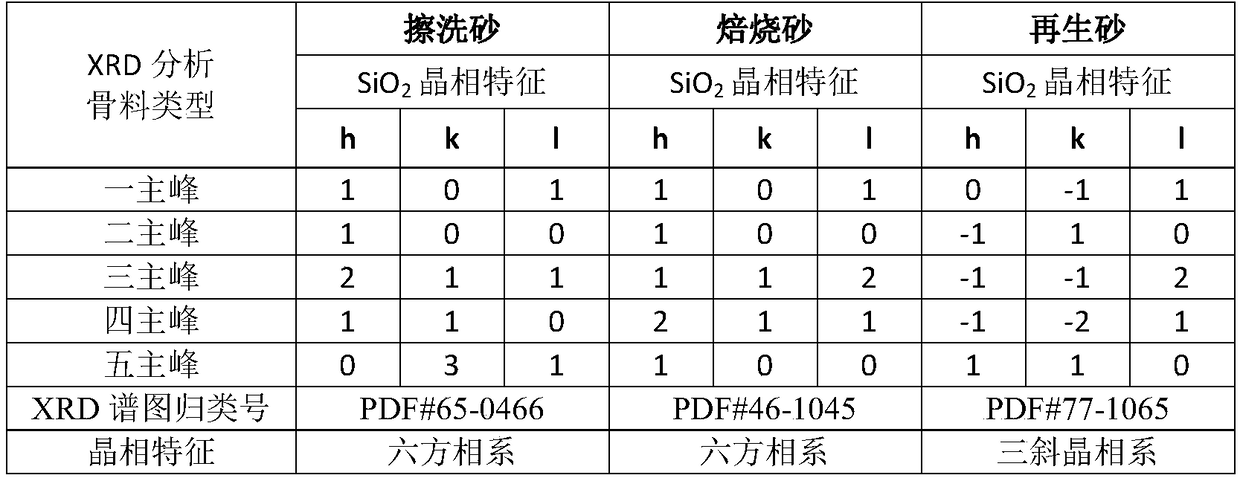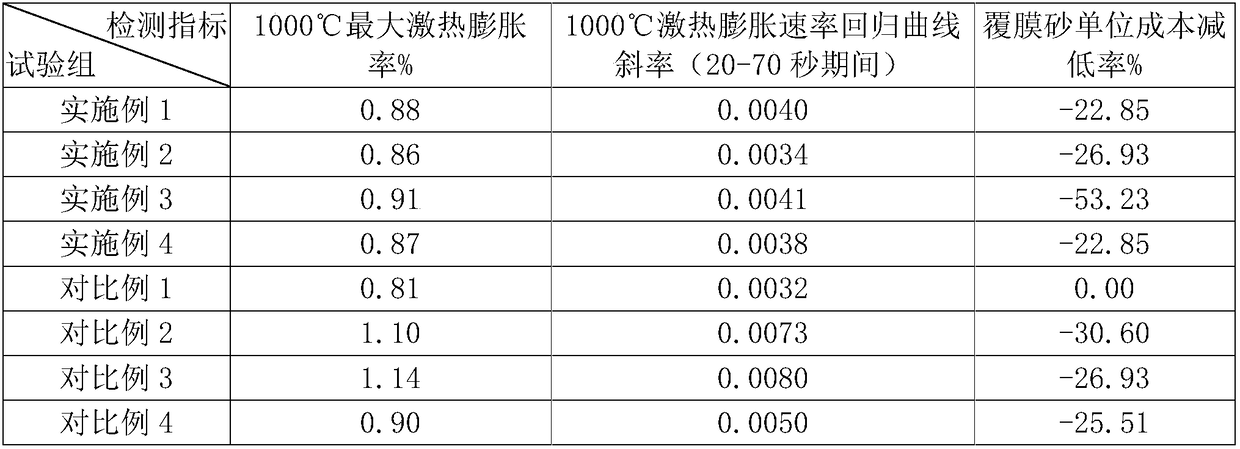Resin precoated sand and preparation method thereof
A technology of resin coating and coating sand, which is applied in the field of foundry molding to achieve the effects of low expansion characteristics, reduced veining, and good coating effect.
- Summary
- Abstract
- Description
- Claims
- Application Information
AI Technical Summary
Problems solved by technology
Method used
Image
Examples
Embodiment 1
[0043] A preparation method of resin-coated sand, comprising the following steps:
[0044] (1) Aggregate: 78.5% of calcined sand and 21.5% of regenerated sand are used to prepare aggregate for coating, which contains 49.4% of low-temperature phase β phase, 40.4% of high-temperature phase α phase, 5.7% of orthoclase, and 5.7% of orthoclase. Plagioclase 4.5%.
[0045] The reclaimed sand includes the following:
[0046] A. Regenerated sand derived from the waste sand formed by phenolic resin-coated sand applied to non-ferrous metal, ferrous metal and cast steel casting by thermomechanical regeneration process;
[0047] B. Regenerated sand obtained by thermo-mechanical regeneration process after applying cold core box resin sand to waste sand formed by casting of non-ferrous and ferrous metals;
[0048] C, derived from the regenerated sand prepared by the thermomechanical regeneration process after the furan resin sand is applied to the waste sand formed by non-ferrous ferrous m...
Embodiment 2
[0056] The difference from Example 1 is that in step (1), 100% of regenerated sand is selected as the aggregate for coating, which contains 0% of low-temperature phase β phase, 95.7% of high-temperature phase α phase, and 4.3% of orthoclase. %, containing plagioclase 0%; in step (2), the amount of thermoplastic resin accounts for 3.5% of the total aggregate amount; in step (3), the aggregate is heated to 140 ° C, the viscosity of thermoplastic resin at 132 ° C Add to the aggregate at 400 cp, add curing agent urotropine accounting for 20% of the resin, and calcium stearate as a release agent accounting for 0.2% of the aggregate to mix sand. The speed of sand mixing is 80r / min. After mixing uniformly, the resin-coated sand is obtained by crushing, screening and cooling, and the total ignition loss of the prepared coated sand is controlled to be 4.5%. Example 3
Embodiment 3
[0057] The difference from Example 1 is that in step (1), 10% of scrubbing sand, 25% of calcined sand, and 65% of regenerated sand are used as aggregates for coating, which contain 25.1% of low-temperature phase β phase and 25.1% of high-temperature phase. α phase 66.3%, orthoclase 7.2%, plagioclase 1.4%; in step (2), the average degree of polymerization of the thermoplastic resin is 8-15, the number-average molecular weight distribution is 800-16000, and the weight-average molecular weight distribution is 900-20,000, wherein the ratio of number-average molecular weight to weight-average molecular weight is between 1.3 and 4, and the amount of thermoplastic resin accounts for 1% of the total aggregate amount; in step (3), the aggregate is heated to 140 ° C, and the thermoplastic resin is in When the viscosity at 130℃ is 450cp, it is added to the aggregate, and the curing agent urotropine, which accounts for 18% of the resin, and the release agent calcium stearate, which account...
PUM
 Login to View More
Login to View More Abstract
Description
Claims
Application Information
 Login to View More
Login to View More - Generate Ideas
- Intellectual Property
- Life Sciences
- Materials
- Tech Scout
- Unparalleled Data Quality
- Higher Quality Content
- 60% Fewer Hallucinations
Browse by: Latest US Patents, China's latest patents, Technical Efficacy Thesaurus, Application Domain, Technology Topic, Popular Technical Reports.
© 2025 PatSnap. All rights reserved.Legal|Privacy policy|Modern Slavery Act Transparency Statement|Sitemap|About US| Contact US: help@patsnap.com



